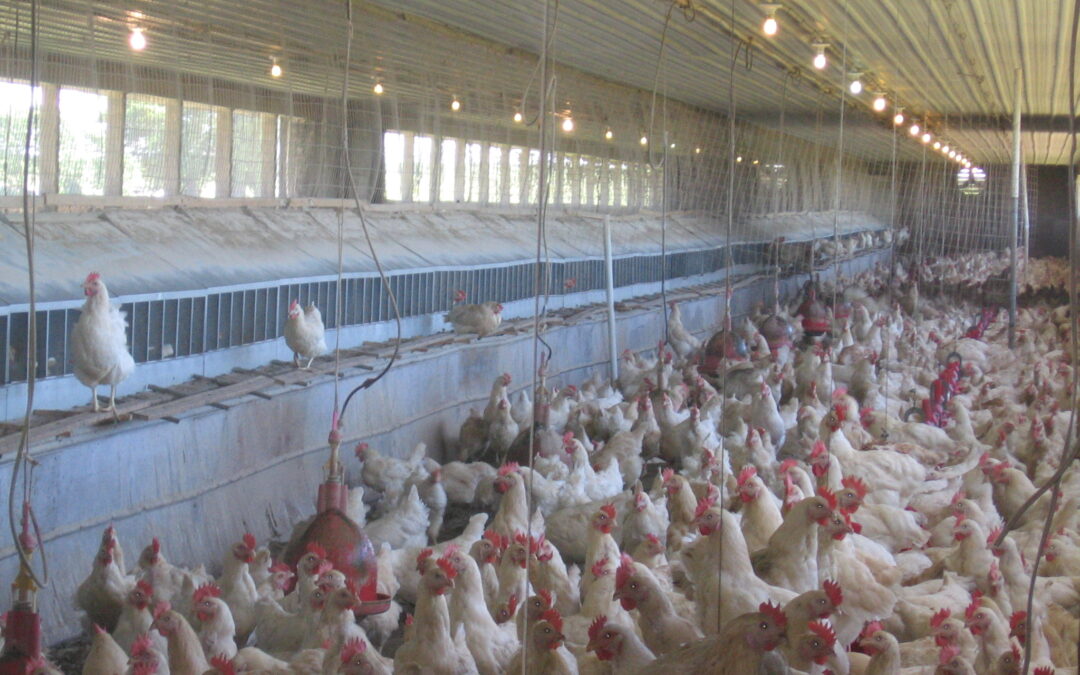USDA Will Permanently Institutionalize Factory Conditions for Organic Poultry
La Farge, Wis. – For most of the last decade and a half, stakeholders in the organic industry have alleged that the largest egg companies in the United States have been operating mammoth livestock factories, with the USDA illegally granting organic certification. In August 2022, the agency released a new draft rule which they purport will bring these operations into compliance, assure a level playing field for competitors, and meet consumer expectations. The rule is currently open for public comment.
Other than family-scale farms producing certified organic eggs, the majority of production takes place on commercial operations—commonly with 20,000-30,000 birds per building—with some of the largest conventional egg marketers in the country operating certified organic houses with as many as 200,000 chickens per building and over a million birds on individual “farms.”
The industry’s most vocal watchdog, OrganicEye, has vociferously criticized the proposed regulations as a giveaway to corporate agribusiness interests, codifying the continuing violations of the spirit and letter of the law by failing to assure that organically managed animals have legitimate access to the outdoors and are able to exhibit their natural instinctual behaviors, both requirements of the current statute and regulations.
OrganicEye’s analysis highlights the fact that, depending on the growing system, the proposed indoor standards allow birds to be stacked in multi-tiered aviaries from floor to ceiling on multiple levels and afforded as little as one square foot per animal.
OrganicEye analysts have also deduced that the new USDA regulations, if adopted, would require only 1-2 ft² outdoors for broilers and laying hens (depending on the weight of the bird). In comparison, a major US marketer, Organic Valley, requires their farmers to provide 5 ft² and European regulations require 43 ft² per bird.
“If that’s not enough of a disincentive for birds to leave the building, even in such overcrowded conditions, the USDA is proposing operators be allowed to cover half of the outdoor area with concrete or gravel,” said Mark Kastel, Executive Director of the Wisconsin-based OrganicEye. “How are the birds going to engage in their natural instinctual behavior—foraging, eating grass, scratching and pecking for bugs and worms—on concrete?”
OrganicEye states that the proposed rules, not unlike much of current organic production, is an affront to consumers who are willing to pay a premium to support truly humane treatment of animals and to secure nutrient-dense and more flavorful food for their families.
“It’s Orwellian doublespeak, intentionally misleading the public, for the USDA to claim that these rules are going to improve the status quo of factory farm production currently dominating organic livestock,” said Kastel. “Or that they represent the expectations of consumers.”
According to OrganicEye, the draft rule allows pullets (young laying hens) to be exclusively confined for the first 16 weeks of their lives and then up to an additional five weeks so the birds can be ‘trained’ to lay eggs in their nesting boxes.
“That’s exclusive confinement for up to the first 21 weeks of the chicken’s life. After all that time indoors, many are scared to go outdoors. And the uninviting semi-enclosed porches and sterile concrete/gravel environments outside of the houses have no food or water or other cultural enrichments to encourage them,” Kastel lamented.
The situation might be considered even worse for broiler chickens, which can be confined exclusively for almost their entire lives before small doors in the houses are opened, commonly, for the last week or two before slaughter.
OrganicEye is asking the USDA to immediately enforce the current law and is appealing to President Biden to personally intervene, since USDA Secretary Thomas Vilsack failed to deliver on a commitment to correct this problem during the Obama administration and now has collaborated with corporate lobbyists in shaping the current proposal.
Organic industry stakeholders, farmers, ethical business professionals, and consumers who want to help shape the rulemaking can learn more by reading the ActionAlert on the OrganicEye website, which includes a link to the organization’s comprehensive formal comments to the USDA.
Other NGOs have also vigorously objected to the proposed phase-in periods for the draft rules (three years for some existing laying houses, up to eight years for new houses, and a widely rejected alternative proposal of 15 years for the large existing livestock factories—currently substituting tiny screened porches for legitimate outdoor access).
OrganicEye is recommending public comments include an appeal to immediately begin enforcing the current federal regulations requiring the opportunity for all animals to access the outdoors. Long-term investigations have shown that, despite the law, almost no organic poultry, including laying hens, broilers, and turkeys, are actually venturing outdoors in commercial production.
OrganicEye Board President Jim Gerritsen, a certified organic farmer in Maine, stated, “While USDA should be codifying the improved welfare of poultry and livestock, and increasing organic integrity, this misguided proposed rule sadly does neither. Rather, it enshrines the very practices which have allowed industrial factory farms to move in, take over, and push out hard-working organic family farms. All of us have a stake in protecting the integrity of organic. We can and must do better.”
-30-
MORE: OrganicEye will hold a virtual press conference and Q&A on the current state of organic egg production, including delineating how the draft rule might make things worse, on Thursday, September 8 at 1:30 pm (EDT) via Facebook Live and Zoom.
Click here to register for the Zoom conference. No pre-registration is necessary to view on OrganicEye’s on Facebook page.

